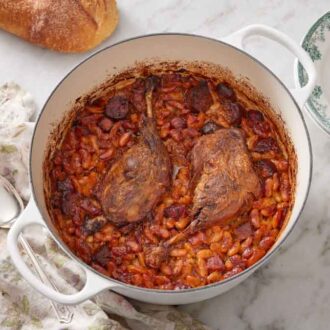
Cassoulet
Duck cassoulet is a decadent, fragrant French stew with white beans, pork, and oodles of flavor. Try it when you have a few hours to spare.
Servings 6 servings
Calories 990kcal
Equipment
- Large Dutch oven
- Large bowl
Ingredients
- 1 pound dried cannellini beans (or Tarbais beans) (450g)
- 4 parsley sprigs
- 4 thyme sprigs
- 2 tablespoons duck fat
- 8 ounces salt pork* cubed (225g)
- 2 duck legs confit* (split into drum and thigh)
- 1 pound garlic sausage links
- 1 onion chopped
- 2 celery stalks chopped
- 1 carrot chopped
- 8 garlic cloves minced
- 3 tablespoons tomato paste
- 2 bay leaves
- 6 to 8 cups unsalted chicken broth (1.4-1.9L)
- ½ teaspoon salt
- ½ teaspoon ground black pepper
Instructions
- In a large bowl, cover the beans with 8 cups of water. Let stand at room temperature overnight or for up to 12 hours. Drain and set aside.
- Tie together the parsley and thyme sprigs, and set aside.
- Heat the duck fat in a large Dutch oven over medium-high heat. Add the salt pork and cook, stirring occasionally, until browned, about 8 to 10 minutes. Remove with a slotted spoon to a large bowl.
- Add the duck confit to the pot, skin side down, and cook until browned, about 5 minutes. Turn the duck and cook until lightly brown on the other side, about 3 minutes. Transfer to bowl with the salt pork.
- Add the sausage to the pot and cook, turning occasionally, until browned on all sides. Cut the sausage into chunks. Transfer to the bowl with the salt pork and duck.
- Drain all but 2 tablespoons of fat from the pot. Reduce the heat to medium and add the onion. Cook until the onion is tender, stirring and scraping up browned bits from the bottom of the pot occasionally, about 5 minutes. Add the celery, carrot, garlic, and tomato paste. Stir constantly for 1 minute. Add the bay leaves, soaked beans, 6 cups of broth, and parsley-thyme bundle to the pot.
- Bring to a boil. Reduce the heat to low, and cover. Simmer, stirring occasionally, until the beans are almost tender, about 45 minutes. Remove from the heat. Discard the parsley, thyme, and bay leaves. Stir in the salt and pepper.
- Adjust the oven rack to the lower third position. Preheat the oven to 300°F.
- Add the browned sausage and salt pork to the pot, stirring to blend well. Arrange the duck confit pieces, skin side up on top. (The beans should be mostly covered with broth with the duck resting on top.)
- Bake, uncovered, until a skin forms on top, about 2 hours. Remove from the oven. Using a large spoon, push down around the sides to collect liquid and spoon over top. If your beans have soaked up all of the liquid, add enough broth to barely cover the beans (1-2 cups), then spoon the liquid over the duck.
- Return to oven and continue to cook until top is a deep brown and a crust forms, about 1 hour. Serve warm with crusty bread.
Notes
- If you can’t find salt pork: Use thick-cut or slab bacon or pancetta but into cubes. You can also use ham hocks, but keep in mind they will smokiness to the stew. Skip browning them and add to the simmering beans, then shred the meat before placing the chicken legs on top.
- If you can’t find duck leg confit: Use regular duck legs or chicken legs and season them generously with salt and pepper before browning. Make sure you use duck fat to brown the legs.
- A note about duck fat: If you use duck confit, there should be enough fat in the packages so you don’t have to buy extra duck fat. If you want to source extra duck fat, you can often find it in specialty or gourmet grocery stores either in the cooking oil section or near the butter. Olive oil can be used in a pinch.
- Use dry white beans: Tarbais beans are the traditional bean in cassoulet, but they are not easy to come by in the US. Cannellini beans are a wonderful substitute, but other white beans like navy beans or Great Northern beans work, too.
- A thick and rich stew: This recipe creates a rich bean stew which a thick broth and tons of flavor. If you want a thinner, more brothy dish, increase the broth amount by 1 cup when initially simmering the beans.
Nutrition
Calories: 990kcal | Carbohydrates: 54g | Protein: 52g | Fat: 63g | Saturated Fat: 21g | Polyunsaturated Fat: 8g | Monounsaturated Fat: 29g | Trans Fat: 0.2g | Cholesterol: 157mg | Sodium: 1908mg | Potassium: 1943mg | Fiber: 13g | Sugar: 4g | Vitamin A: 1975IU | Vitamin C: 8mg | Calcium: 229mg | Iron: 11mg